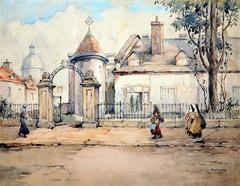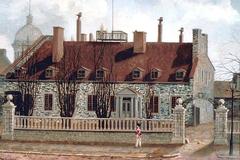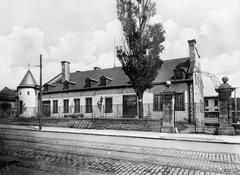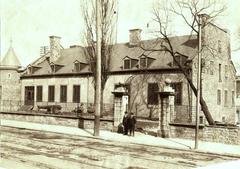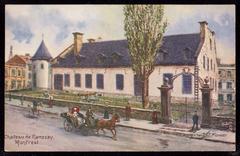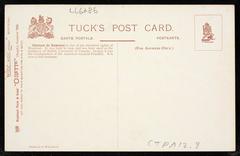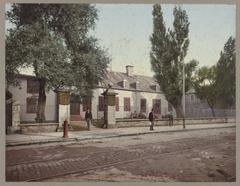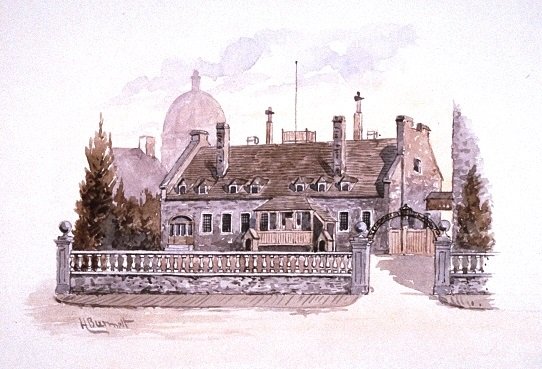
Château Ramezay: Visiting Hours, Tickets, and Historical Sites in Montreal
Date: 14/06/2025
Introduction: Discovering Château Ramezay’s Historical Legacy
Château Ramezay, located in the vibrant heart of Old Montreal, stands as a remarkable testament to Quebec’s colonial history and architectural heritage. Built in 1705 by Claude de Ramezay, then Governor of Montreal, this iconic site offers visitors a unique journey through centuries of political, social, and cultural evolution. From its origins in New France through periods of British rule, revolutionary intrigue, and its present role as a leading museum, Château Ramezay encapsulates the richness of Montreal’s past and its ongoing cultural significance (Bonjour Québec; Château Ramezay Museum).
This comprehensive guide details everything you need to plan your visit: opening hours, ticket information, accessibility, must-see exhibitions, and practical tips for making the most of your time at one of Montreal’s premier historical sites.
Table of Contents
- Introduction
- Origins and Construction
- Role in Colonial Administration
- American Revolution and the Château
- 19th-Century Transformations
- Museum Era and Preservation
- Architectural Features and Gardens
- Cultural Significance
- Visitor Experience
- FAQ
- Conclusion
- References
Origins and Construction
Commissioned by Claude de Ramezay in 1705, the château was constructed as his official residence and a symbol of French colonial authority. Master mason Pierre Couturier designed the original three-storey stone structure, which was completed in 1706 and featured robust walls, a steeply pitched roof, and elegant period details. The surrounding gardens and outbuildings, such as an icehouse and stables, reflected both the prestige of its owner and the practical needs of an 18th-century estate (Bonjour Québec; Canadian Encyclopedia).
Over time, the château was expanded and renovated, eventually becoming a prominent fixture on Notre-Dame Street and a focal point of Montreal’s political life.
Role in Colonial Administration
Throughout the French colonial period, Château Ramezay was more than a private residence. After Claude de Ramezay’s death in 1724, it changed hands several times, serving as the headquarters for the Compagnie des Indes (French East India Company) and later as the residence of British governors after the conquest of Montreal in 1760. The building retained its French architectural character, symbolizing the city’s layered colonial heritage (Canadian Encyclopedia).
The Château and the American Revolution
During the American Revolutionary War, the château was occupied by the Continental Army in 1775–1776. It served as headquarters for American forces, hosting leaders such as Benedict Arnold and Benjamin Franklin, who attempted—unsuccessfully—to persuade Quebec to join the revolution (Bonjour Québec). Artifacts and archival documents from this era are now part of the museum’s collection.
19th-Century Transformations
In the 19th century, the building underwent significant changes. It was sold to private owners, served various civic functions—including as a courthouse and school—and was eventually acquired by the Montreal Numismatic and Antiquarian Society in 1878, which preserved and restored the château, paving the way for its transformation into a museum.
Museum Era and Preservation
Château Ramezay opened as a museum in 1895, becoming Quebec’s oldest private history museum. Its collections now encompass over 30,000 artifacts, documents, and artworks that chronicle Montreal’s development from Indigenous settlement to a major metropolis (Bonjour Québec). The château was designated a National Historic Site of Canada in 1949, and ongoing restoration efforts have preserved its architectural and historical authenticity (Parks Canada).
Architectural Features and Gardens
French Colonial Design
Constructed in the French colonial style, Château Ramezay is characterized by thick stone walls, steep roofs, and symmetrical facades. The original building, with its elegant proportions and functional outbuildings, reflected the tastes of Montreal’s colonial elite (Château Ramezay Museum).
Expansion and Modifications
After a fire in 1756, the Compagnie des Indes enlarged the structure, adding new rooms and enhancing its administrative functions. Twentieth-century renovations restored many original features while updating the building for museum use (Canadian Encyclopedia; Parks Canada).
Interior Highlights
Visitors can explore 15 period rooms, including the Salle de Nantes—a formal reception hall featuring hand-carved mahogany panels. The basement showcases reconstructed colonial kitchens and dining spaces, brought to life with interactive exhibits and multimedia presentations (The Geographical Cure).
The Governor’s Garden
Behind the château lies the Governor’s Garden, a recreated 18th-century French formal garden with sections for kitchen plants, orchards, ornamental flowers, and medicinal herbs. Open free of charge from June to September, it offers a tranquil oasis and insight into colonial horticultural traditions (Château Ramezay Museum; The Geographical Cure).
Cultural Significance
Political and Social Influence
Château Ramezay’s grandeur reflects its status as a center of political and commercial power. It served as a residence, administrative headquarters, and even as a base for the American Continental Army, underscoring its historical importance (Château Ramezay Museum).
Witness to Historic Events
The château has hosted leaders and witnessed events that shaped Canadian and North American history, from colonial governance to revolutionary diplomacy (Wikipedia; The Geographical Cure).
Heritage Preservation and Museum Role
The museum’s collections span art, manuscripts, ethnological artifacts, and photographs—offering a comprehensive narrative of Montreal’s past and preserving its tangible and intangible heritage (Montreal Visitors Guide; Château Ramezay Museum). Recognized for its preservation efforts, Château Ramezay is both a historic monument and a National Historic Site (Canadian Encyclopedia).
Cultural Programming and Community Involvement
The museum hosts educational programs, lectures, workshops, and community events, engaging diverse audiences and fostering appreciation for Montreal’s multicultural heritage (Château Ramezay Museum).
Architectural Restoration
Major renovations have restored the château’s historical integrity, earning awards and positioning it as a model for heritage conservation (Canadian Encyclopedia).
Visitor Experience
Arrival and First Impressions
Château Ramezay is situated at 280 Notre-Dame Street East, opposite City Hall and Place Jacques-Cartier. Its historic stone façade and inviting entrance welcome visitors to an immersive historical experience (Condé Nast Traveler).
Visiting Hours and Tickets
- Hours: Open Tuesday–Sunday, 10:00 AM–5:00 PM; closed Mondays and major holidays. The Governor’s Garden closes at 4:30 PM. Always confirm current hours on the official website.
- Tickets: Admission is approximately $30 CAD (tax included) as of 2025, with discounts for seniors, students, families, and members. Purchase online or at the museum to avoid queues (Château Ramezay official site).
Accessibility and Navigation
Château Ramezay is fully accessible, equipped with ramps, elevators, and accessible restrooms. The compact museum layout, clear signage, and helpful staff ensure a comfortable visit for all guests (Condé Nast Traveler).
Permanent and Rotating Exhibitions
The museum’s permanent exhibitions recount Montreal’s evolution from Indigenous settlement (Hochelaga) to the present, with reconstructed period rooms and immersive storytelling. Rotating exhibitions provide fresh perspectives on various historical topics (Condé Nast Traveler).
Guided Tours and Governor’s Garden
Guided tours led by costumed interpreters are offered daily in summer and on weekends in other seasons, included with admission. The Governor’s Garden, accessible to all, is a tranquil retreat and educational resource (Château Ramezay Museum).
Facilities and Amenities
- Restrooms and Seating: Available throughout the museum and gardens.
- Gift Shop: Modest in size; additional souvenir options can be found nearby.
- Food: No on-site café, but Old Montreal offers a variety of dining choices.
Practical Tips
- Best Times to Visit: Weekday mornings or late afternoons for fewer crowds.
- Photography: Non-flash photography permitted unless otherwise indicated.
- Language: Tours and exhibits in French and English.
- Transportation: Five-minute walk from Champ-de-Mars metro; paid parking nearby.
Nearby Attractions
Combine your visit with other Old Montreal landmarks, such as Place Jacques-Cartier, Notre-Dame Basilica, Pointe-à-Callière Museum, and the Old Port (Petit Futé).
Visitor Reviews
Guests consistently praise the museum’s well-curated exhibits, knowledgeable guides, and the unique atmosphere of the historic building. The Governor’s Garden is frequently highlighted as a must-see.
Frequently Asked Questions (FAQ)
Q: What are Château Ramezay’s visiting hours?
A: Open Tuesday–Sunday, 10:00 AM–5:00 PM; closed Mondays and holidays. The garden closes at 4:30 PM.
Q: How much are tickets?
A: Approximately $30 CAD (tax included), with discounts for eligible groups.
Q: Is the museum wheelchair accessible?
A: Yes, with accessible routes, ramps, and elevators.
Q: Are guided tours available?
A: Yes, included with admission. Offered daily in summer and weekends during other seasons.
Q: Can I take photographs?
A: Non-flash photography is permitted unless otherwise noted.
Q: Where is Château Ramezay located?
A: 280 Notre-Dame Street East, Old Montreal, near Champ-de-Mars metro.
Conclusion
Château Ramezay is a cornerstone of Montreal’s historical and cultural landscape, offering a fascinating glimpse into the city’s colonial past, architectural beauty, and evolving identity. With engaging exhibits, beautiful gardens, accessible facilities, and a central location, it is an essential destination for anyone exploring Montreal historical sites. Plan your visit today and immerse yourself in centuries of history.
For more details, ticket purchases, and updates, visit the official Château Ramezay website. Download the Audiala app for audio tours and follow the museum on social media for news and events.
References
- Château Ramezay Museum, 2024, Official Website (https://www.chateauramezay.qc.ca/en/)
- Bonjour Québec, 2024, Château Ramezay Historic Site (https://www.bonjourquebec.com/en-us/listing/to-see-and-do/chateau-ramezay-musee-et-site-historique-de-montreal/0p4w)
- Canadian Encyclopedia, 2024, Le Château Ramezay (https://www.thecanadianencyclopedia.ca/en/article/le-chateau-ramezay)
- Parks Canada, 2024, Château Ramezay National Historic Site (https://www.pc.gc.ca/apps/dfhd/page_nhs_eng.aspx?id=643)
- Condé Nast Traveler, 2024, Château Ramezay Visitor Experience (https://www.cntraveler.com/activities/montreal/chateau-ramezay)
- Petit Futé, 2024, Visitor Reviews and Tips (https://www.petitfute.com/v47599-montreal/c1173-visites-points-d-interet/c976-archeologie-artisanat-science-et-technique/378450-chateau-ramezay/tous-les-avis.html)

